Solar eclipse of May 29, 1919
| Solar eclipse of May 29, 1919 | |
|---|---|
|
From the report of Sir Arthur Eddington on the expedition to the island of Principe (off the west coast of Africa). | |
 Map | |
| Type of eclipse | |
| Nature | Total |
| Gamma | -0.2955 |
| Magnitude | 1.0719 |
| Maximum eclipse | |
| Duration | 411 sec (6 m 51 s) |
| Coordinates | 4°24′N 16°42′W / 4.4°N 16.7°W |
| Max. width of band | 244 km (152 mi) |
| Times (UTC) | |
| Greatest eclipse | 13:08:55 |
| References | |
| Saros | 136 (32 of 71) |
| Catalog # (SE5000) | 9326 |
A total solar eclipse occurred on May 29, 1919. With a maximum duration of totality of 6 minutes 51 seconds, it was one of the longest solar eclipses of the 20th century. It was visible throughout most of South America and Africa as a partial eclipse. Totality occurred through a narrow path across central Brazil after sunrise, across the Atlantic Ocean and into south central Africa ending near sunset in eastern Africa.
Observations
Albert Einstein's prediction of the bending of light by the gravity of the Sun, one of the predictions of his general theory of relativity, can be tested during a solar eclipse, when stars with apparent position near the sun become visible. Following an unsuccessful attempt to validate the prediction of light bending by the sun during the Solar eclipse of June 8, 1918,[1] two expeditions were made to measure positions of stars during this eclipse. The first was lead by Sir Frank Watson Dyson and Sir Arthur Eddington to the island of Principe (off the west coast of Africa), the second by Andrew Claude de la Cherois Crommelin and Charles Davidson to Sobral in Brazil.[2] . The stars which both expeditions observed were in the constellation Taurus.[3]
Related eclipses
Solar eclipses 1916–1920
Each member in a semester series of solar eclipses repeats approximately every 177 days and 4 hours (a semester) at alternating nodes of the Moon's orbit.
| Solar eclipse series sets from 1916–1920 | ||||
|---|---|---|---|---|
| Ascending node | Descending node | |||
| 111 | December 24, 1916 Partial |
116 | June 19, 1917 Partial | |
| 121 | December 14, 1917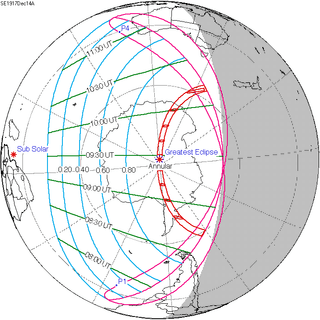 Annular |
126 | June 8, 1918 Total | |
| 131 | December 3, 1918 Annular |
136 | May 29, 1919 Total | |
| 141 | November 22, 1919 Annular |
146 | May 18, 1920 Partial | |
| 151 | November 10, 1920 Partial | |||
Saros 136
Solar Saros 136, repeating every 18 years, 11 days, contains 71 events. The series started with partial solar eclipse on June 14, 1360, and reached a first annular eclipse on September 8, 1504. It was a hybrid event from November 22, 1612, through January 17, 1703, and total eclipses from January 27, 1721 through May 13, 2496. The series ends at member 71 as a partial eclipse on July 30, 2622, with the entire series lasting 1262 years. The longest eclipse occurred on June 20, 1955, with a maximum duration of totality at 7 minutes, 8 seconds.[4]
| Series members 29–43 occur between 1865 and 2117 | ||
|---|---|---|
| 29 | 30 | 31 |
 Apr 25, 1865 |
 May 6, 1883 |
 May 18, 1901 |
| 32 | 33 | 34 |
 May 29, 1919 |
 Jun 8, 1937 |
 Jun 20, 1955 |
| 35 | 36 | 37 |
 Jun 30, 1973 |
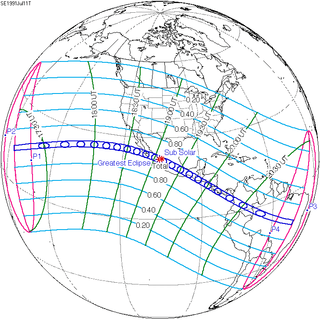 Jul 11, 1991 |
 Jul 22, 2009 |
| 38 | 39 | 40 |
 Aug 2, 2027 |
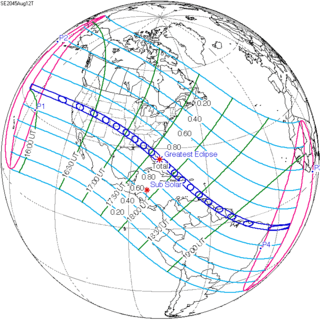 Aug 12, 2045 |
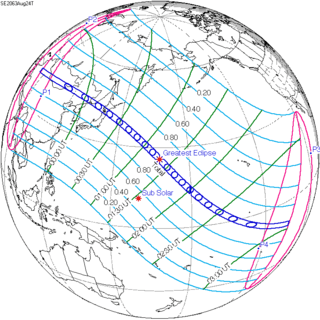 Aug 24, 2063 |
| 41 | 42 | 43 |
 Sep 3, 2081 |
 Sep 14, 2099 |
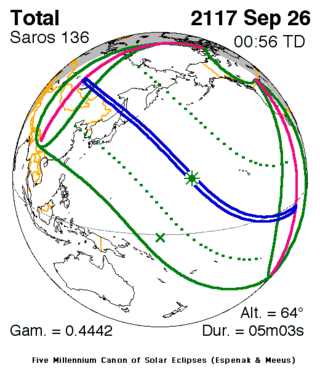 Sep 26, 2117 |
Notes
- ↑ Ethan Siegel, "America's Previous Coast-To-Coast Eclipse Almost Proved Einstein Right", Forbes, Aug 4, 2017. Retrieved August 4, 2017.
- ↑ Longair, Malcolm (2015-04-13). "Bending space–time: a commentary on Dyson, Eddington and Davidson (1920) ‘A determination of the deflection of light by the Sun9s gravitational field’". Phil. Trans. R. Soc. A. 373 (2039): 20140287. ISSN 1364-503X. PMC 4360090
 . PMID 25750149. doi:10.1098/rsta.2014.0287.
. PMID 25750149. doi:10.1098/rsta.2014.0287. - ↑ F. W. Dyson, A. S. Eddington, and C. Davidson (1920). "A Determination of the Deflection of Light by the Sun's Gravitational Field, from Observations Made at the Total Eclipse of May 29, 1919" (PDF). Philosophical Transactions of the Royal Society of London. CCXX-A 579: 291–333. doi:10.1098/rsta.1920.0009.
- ↑ SEsaros136 at NASA.gov
References
- NASA chart and statistics
- Fotos of Solar Corona May 29, 1919
- Wired.com: May 29, 1919: A Major Eclipse, Relatively Speaking
- Famous Eclipse of 1919
| Wikimedia Commons has media related to Solar eclipse of 1919 May 29. |

